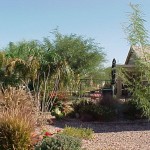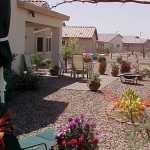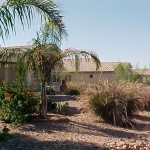What a difference two years makes! Jack’s desert oasis continues to boast color, shade and comfort. But look at how everything has filled in as it matured!
Notice the mesquite tree and how the green leaves provide shade and background for the colors throughout. The green from the tree, and surrounding plants, add a softness and shade to the landscape. Colors from potted plants and blooming plants really pop against the soothing backdrop.
Jack’s design brilliantly relies on a lot of desert plants, so almost everything works with the climate — meaning less work to keep everything thriving.
One casualty from the original design: a Queen Palm. As Jack says:
One has lived and I cut the other down…my nursery has quit stocking them as they freeze too easily and suffer from the heat. They need to be on the coast in Southern California.
Best of all, everything works together in scale. From the beginning, Jack left space for the plants to mature. (Compare this “after” photo to the beginning landscape.) That’s one of the most difficult disciplines for beginning a garden — resisting the urge to fill in the space NOW, only to have to cull good plants later because of crowding. Jack avoided this by planning for the space at the yard’s inception.
Tip: ask your local nursery how long it takes for a plant to reach maturity and for them to “fill in”. You can also check the tags on the plant as you shop. Then take a measure out to the garden and space plants according to their full anticipated size before you dig.


